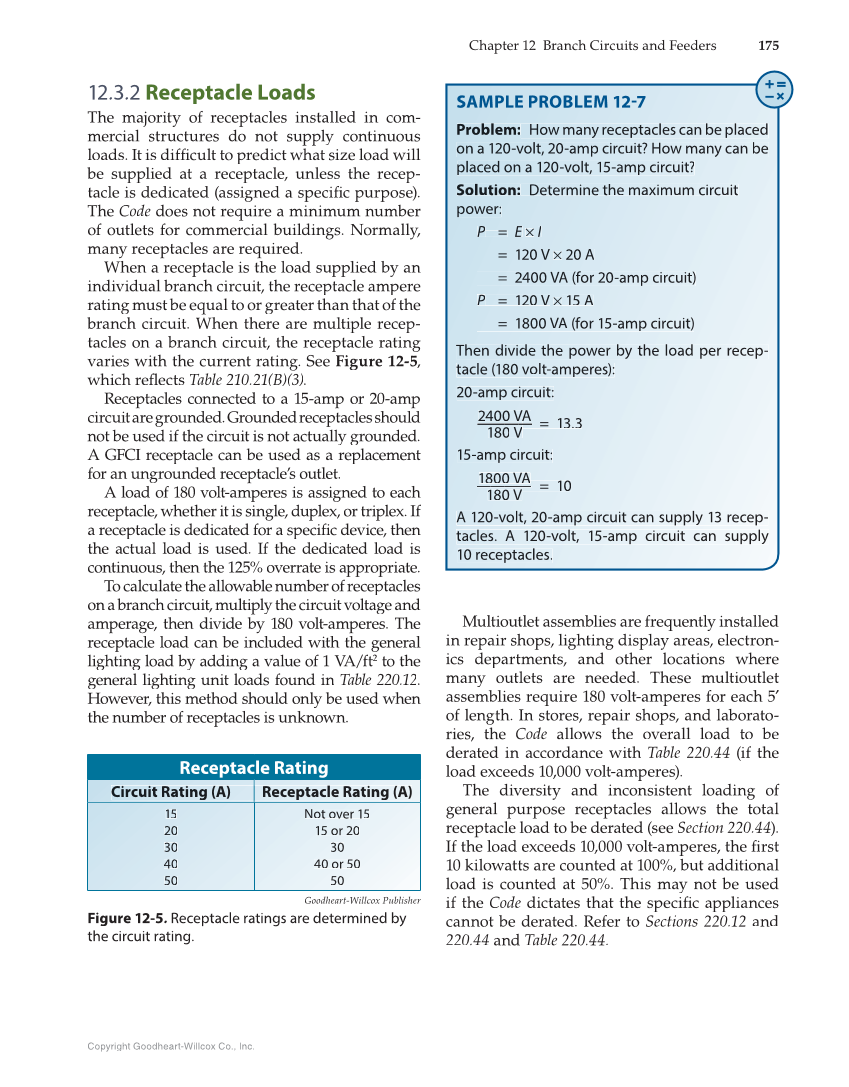Chapter 12 Branch Circuits and Feeders 175 Copyright Goodheart-Willcox Co., Inc. 12.3.2 Receptacle Loads The majority of receptacles installed in com- mercial structures do not supply continuous loads. It is diffi to predict what size load will ficult be supplied at a receptacle, unless the recep- tacle is dedicated (assigned a specific purpose). fi The Code does not require a minimum number of outlets for commercial buildings. Normally, many receptacles are required. When a receptacle is the load supplied by an individual branch circuit, the receptacle ampere rating must be equal to or greater than that of the branch circuit. When there are multiple recep- tacles on a branch circuit, the receptacle rating varies with the current rating. See Figure 12-5, 5 which refl flects Table 210.21(B)(3). Receptacles connected to a 15-amp or 20-amp circuit are grounded.Groundedreceptaclesshould not be used if the circuit is not actually grounded. A GFCI receptacle can be used as a replacement for an ungrounded receptacle’s outlet. A load of 180 volt-amperes is assigned to each receptacle, whether it is single, duplex, or triplex. If a receptacle is dedicated for a specific device, then fi fi the actual load is used. If the dedicated load is continuous, then the 125% overrate is appropriate. To calculate the allowable number of receptacles on a branch circuit, multiply the circuit voltage and amperage, then divide by 180 volt-amperes. The receptacle load can be included with the general lighting load by adding a value of 1 VA/ft2 to the general lighting unit loads found in Table 220.12. However, this method should only be used when the number of receptacles is unknown. Goodheart-Willcox Publisher Figure 12-5. Receptacle ratings are determined by the circuit rating. Receptacle Rating Circuit Rating (A) Receptacle Rating g (A) (A 15 20 30 0 40 50 Not over 15 5 15 or 20 20 30 30 4 40 or 50 50 Multioutlet assemblies are frequently installed in repair shops, lighting display areas, electron- ics departments, and other locations where many outlets are needed. These multioutlet assemblies require 180 volt-amperes for each 5′ of length. In stores, repair shops, and laborato- ries, the Code allows the overall load to be derated in accordance with Table 220.44 (if the load exceeds 10,000 volt-amperes). The diversity and inconsistent loading of general purpose receptacles allows the total receptacle load to be derated (see Section 220.44). If the load exceeds 10,000 volt-amperes, the first fi 10 kilowatts are counted at 100%, but additional load is counted at 50%. This may not be used if the Code dictates that the specific appliances fi cannot be derated. Refer to Sections 220.12 and 220.44 and Table 220.44. SAMPLE PROBLEM 12-7 P Pr oblem: How many receptacles t can be placed on a 120-volt, 20-amp circuit? ui How many can be placed on a 120-volt, 15-am a mp circuit? Solution: Determine the he maximum circuit power: P = P E × I = 120 V × 20 A A = 2400 VA (f ( fo r 20-amp circuit) P = 120 V P × 15 1 A = 1800 V VA (for 15-amp circuit) Then divide t th e power by the load per recep- re tacle (180 vo ol t-amperes): 20-amp circuit: r 2400 VA V ____ _ 180 0 V = 13.3 V A _ V 15-am mp circuit: 18___ 18 00 VA _ _ 180 V = 10 VA _ V A A 120-volt, 20-amp circuit can supply s 13 recep- t ta cles. A 120-volt, 15-amp circuit c can supply 10 receptacles.
